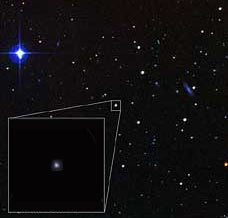For the past 25 years, astronomers have been searching for the first stars, made from the primordial hydrogen and helium created in the Big Bang 13.7 billion years ago. Now the two leading candidates — recently discovered stars with almost no heavier elements in their atmospheres — have run into problems. Analysis of their ratios of heavier elements to hydrogen indicates they were seeded by stardust from an earlier generation of stars.
Most of the stars that formed from the nearly pure hydrogen and helium created in the first 15 minutes of the Big Bang were hundreds of times more massive than the Sun, and exploded within a few million years. Still, if those short-lived giants had smaller siblings, some could still be around. Surviving first-generation stars would advertise their age by the near absence of “metals” — elements heavier than hydrogen and helium — in their spectra.
It seemed possible that just such a star had been found in 2002, when Norbert Christlieb at the University of Hamburg in Germany discovered the first hyper metal-poor (HMP) star, in the Milky Way’s halo. The low-mass star, with the undistinguished designation HE0107-5240, contains just 1/200,000 of the Sun’s metal abundance.
Astronomers agree these two HMP stars almost certainly formed soon after the Big Bang but debate whether they belong to the first generation of stars.
Ken’ichi Nomoto of the University of Tokyo and his colleagues used computer simulations to reproduce the “extremely peculiar” ratios of elements found in the two HMP stars. The stars have almost identically low ratios of iron and carbon, but HE1327-2326 has a nitrogen-to-carbon ratio 10 times greater than HE0107-5240.
Nomoto’s group found it could make sense of the stars’ chemical similarities and differences only if they had formed from gas enriched by the explosion of “faint” supernovae. The researchers describe their findings in the June 3 issue of Science.
The group found stars 25 times more massive than the Sun would explode as supernovae and end up as black holes. The amount of carbon, iron, and other “metals” ejected into space depended on how fast the stars rotated. Slightly different rotation rates could reproduce the precise mix found in the HMP stars.
“Such peculiar abundance ratios … can only have resulted from nucleosynthesis of the earlier, first generation, supernovae,” Nomoto tells Astronomy. “With the effect of rotation, a tiny amount of iron and other heavy elements can be ejected, but their elemental abundance ratios differ according to the difference in the rotation.”
In an invited commentary accompanying the group’s Science article, Timothy Beers of Michigan State University emphasizes the importance of further studying the earliest stars. “Dedicated high-resolution spectroscopic studies of these stars will reveal the detailed patterns of elements created by the early generations of stars in the Milky Way,” he writes, “and form the basis for assembling the ‘story of creation’ of the elements that eventually have been incorporated into all of us.”










